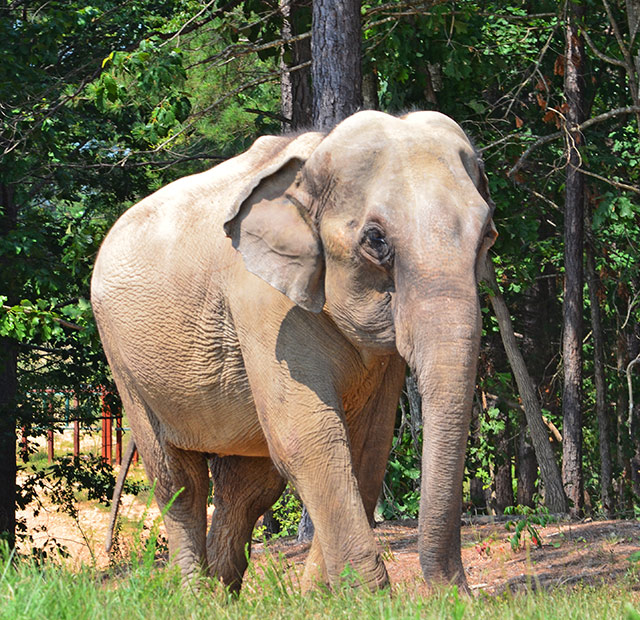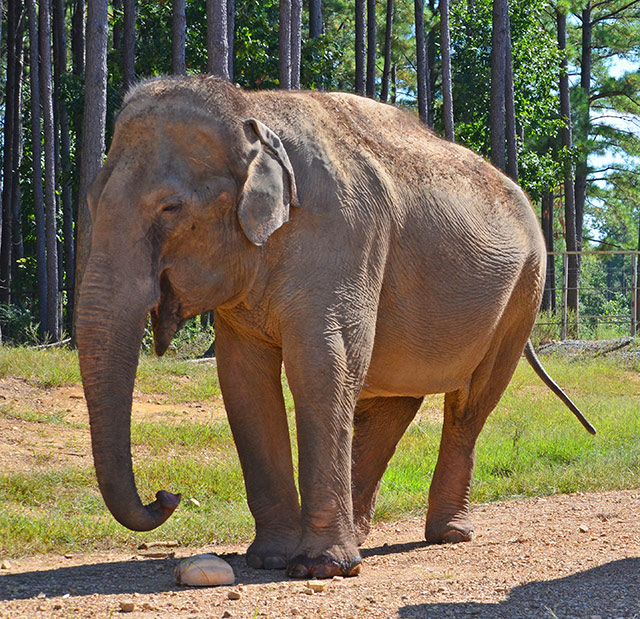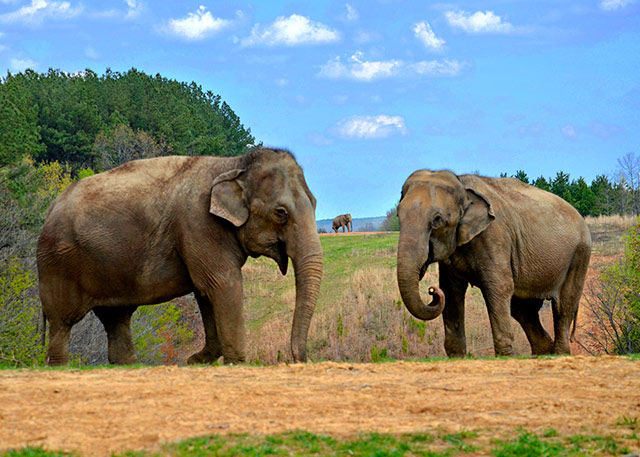An Update on Sissy and Winkie
At the Asia Habitat recently, elephants “Sissy” (age 46) and “Winkie” (age 48) have been making the most of expanded acreage. After spending 60 days in “quarantine” –on 16 acres of forest, ponds, and pasture– Sissy and Winkie have been spending the month of October, with its mild days and cool nights, stretching their legs and exploring less-traveled areas of their 2100-acre preserve.
Earlier in 2014, Sissy and Winkie were shown to be reactive on a DPP serological blood test; meaning, at some point in their lives, they were exposed to the tuberculosis bacteria. They are now on a prophylactic [preventative] antibiotic drug regimen, of which their first 60 days was successfully completed this month. As a result, they have now reached therapeutic drug-levels; meaning, they are able to be reunited with their “sisters” at Asia without risk of transmitting latent TB to the other Girls.

Sissy in the woods at Asia; Aug. 4, 2014
Neither Sissy nor Winkie have ever tested positive for active TB via a trunk-wash test while at Sanctuary. Their herd mates in the Asia Habitat –elephants “Misty,” “Shirley,” and “Tarra”– continue to test negative for TB on both their DPP and trunk-wash results.
In 2004, elephant “Misty” arrived with an active case of tuberculosis; she was treated with antibiotics and then in 2006 moved to the new Asian barn (along with the rest of the Asian herd) to make room for eight elephants from the Hawthorn Corporation.
“Sanctuary elephants lived hard lives in circuses and zoos, traveled extensively, and in many cases we simply do not have complete health histories on them,” said the Sanctuary’s Director of Veterinary Care, Dr. Steven Scott. “As these elephants come from variant backgrounds, we are glad to have the more sensitive blood test available to us now, so that we can better ensure their health and safety, as well as prevent the spread of TB to other animals and humans.”
Sissy and Winkie are in good health, and are daily monitored by Asia Barn’s Care staff, Attending Veterinarian Dr. Scott (who’s served TES elephants since the organization’s 1995 inception), and Resident Veterinarian, Dr. Lydia Young. The Elephant Sanctuary’s integrated veterinary and husbandry team keeps a close eye on Sissy and Winkie –as well as the TB-exposed residents of the “Q” (Quarantine) habitat– to monitor any apparent side-effects of TB treatment, including weight loss.

Winkie at Asia; Sept. 24, 2014
Sissy and Winkie underwent a full body-condition review by the Vet team this week. Using industry-standard body-condition scoring indexes1 for elephants, Sissy and Winkie’s body conditions are considered ‘ideal.’ This represented no change from body-condition scores performed two months’ prior.
Sissy and Winkie take their preventative antibiotics every day: Sissy takes hers in a mixture of Grandma’s Molasses and oats, and Winkie takes hers in a mixture of peanut-butter and calf-manna (grain). During their eight weeks spent closer to the barn, Care staff were able to accomplish a lot of Protected-Contact training, therapeutic foot-care, and enrichment activities with the two Girls – and they seemed to relish the extra attention!
Both Sissy and Winkie spent approximately three decades each in zoo-exhibits, and both arrived at Sanctuary in 2000 with reputations as “dangerous” elephants. Sissy was retired from the El Paso Zoo after a public outcry over her treatment there; Winkie was retired from the Henry Vilas Zoo (Madison, Wisc.) after USDA asked that the Zoo either improve its exhibit, or relocate their elephants.
The Elephant Sanctuary serves as a forever home for North America’s captive elephants once owners are prepared to retire them. Sanctuary staff is open to conversations with community stakeholders and legal guardians about options for long-term elephant care. The Elephant Sanctuary is available to elephants in need of retirement, and that meet Tennessee’s guidelines for importation across state lines.

From the Sanctuary’s 2015 Calendar, Winkie & Sissy (Shirley at rear); May 2014
More about TB in captive elephants:
According to USDA regulatory standards, all captive elephants must be monitored for the presence of tuberculosis via an annual trunk-wash test. While The Elephant Sanctuary has followed this protocol, earlier this year The Sanctuary also began voluntary implementation of more scientifically-advanced, serological blood testing of elephants in order to proactively monitor evidence of TB-exposure.
Detection of TB-bacteria in lab-cultures from trunk washes turn up positive only when elephants are actively shedding TB, giving rise to high instances of false-negative results. While trunk-washes are still the most accurate test to reveal active disease, current veterinary science has placed an approximate 3%-effective rate on a trunk-wash’s ability to reliably detect TB in elephants. The more reliable test is a serological blood test known as Dual Path Platform (DPP), which has come available in the last five years and has a 90-percent rate of effectiveness. It is for these reasons that The Sanctuary voluntarily moved toward more sensitive testing protocols for TB in elephants.
“The Elephant Sanctuary has been one of several collaborative, cooperative partners to TWRA on broadening the understanding of TB in elephants” said Walter Cook, Captive Wildlife Officer for Tennessee Wildlife Resources Agency. “Their veterinary and husbandry teams have experienced success in the administration of tuberculosis therapies, and TWRA’s conditions set for Sanctuary on TB testing and treatment are being met.”
________________________
1 Morfeld, K. et. al. published 2014; Wemmer et. al. published 2006
